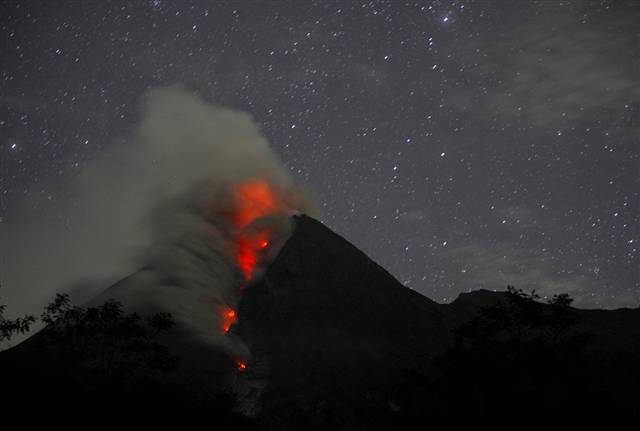
Men with ash-covered faces streamed down Mount Merapi on motorcycles followed by truckloads of women and crying children, following the massive eruption just before midnight Friday.
Even staff at the mountain's main monitoring post were told to move farther from the glowing crater.
Hospital spokesman Heru Nugroho said 48 bodies were brought in after the inferno. More than 65 others were injured, many of them critically.
Soldiers helped clear the bodies from the hard-hit village of Bronggang, located 9 miles (15 kilometers) from the crater, bringing them to the hospital morgue.
It was not immediately clear why families living within Merapi's "danger zone" had not been evacuated.
Mount Merapi, which means "Fire Mountain," has killed at least 92 people since bursting back to life on Oct. 26.
Though scientists earlier expressed hope dozens of big explosions in the last week would ease pressure building up behind a magma dome high up in the crater, eruptions Friday appeared to be intensifying.
"We have no idea what to expect now," said Surono, a state expert on volcanos, adding that he has never seen the needle on Merapi's seismograph working with such intensity.
Towering clouds of ash shot from the crater with a thunder-like roar on Thursday morning, sending soot 20,000 feet (6,000 meters) into the air and dusting towns up to 150 miles (250 kilometers) away.
Just before midnight, Merapi unleashed a deadly surge of searing ash, gases and rock fragments. Known to experts as pyroclastic flows, such clouds race down the slopes at speeds of up to 60 miles per hour (100 kilometers per hour).
Though more than 75,000 people living along Merapi's fertile slopes have been evacuated to crowded emergency shelters, many by force, others are reluctant to leave their precious livestock and homes.
It is not clear how many people were in the village of Bronggang, nine miles (15 kilometers) from the crater, when the heat cloud hit.
Activity at the mountain has at times briefly forced airports in Yogyakarta and nearby Solo to close and the Transportation Ministry reiterated Thursday that flight paths near the mountain had been shut down for safety reasons. Heavy ash and volcanic debris has been known to affect visibility and clog engines.
Officials insisted, however, that a Qantas jetliner forced to make an emergency landing after one of its four engines failed over Batam, an island 800 miles (1,400 kilometers) to the west, was unrelated.
"There was no connection with Mount Merapi," said Bambang Ervan, a spokesman for the Transportation Ministry. "It was too far from the volcano - the sky over Singapore and Sumatra island is free of dust."
Merapi has erupted many times in the last century, often with deadly results. In 1994, 60 people were killed, while in 1930, more than a dozen villages were torched, leaving up to 1,300 dead.
Subandrio, a state volcanologist, said Mount Merapi's "danger zone" was widened by three miles (five kilometers) early Friday. With that order, people living in villages and emergency camps within 12 miles (20 kilometers) of the crater have to move.
Indonesia, a vast archipelago of 235 million people, is prone to earthquakes and volcanos because it sits along the Pacific "Ring of Fire," a horseshoe-shaped string of faults that lines the Pacific Ocean.
The volcano's initial blast occurred less than 24 hours after a towering tsunami slammed into the remote Mentawai islands on the western end of the country, sweeping entire villages to sea and killing at least 428 people.
There, too, thousands of people were displaced, many living in government camps.
Source: Reuters



Reader Comments
to our Newsletter